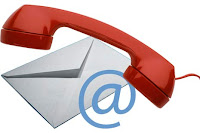THE DIFFERENCE BETWEEN GOOD AND BAD EMAILS
My name is Melinda and I will be sharing facts and opinions about email writing and the differences between good and bad emails.
Electronic mail (email) is transmitted from an author to one or more recipients. Network based emails are exchanged and carried by the Simple Mail Transfer Protocol (SMTP) and this is the Internet Standard. httcp://en.wikipedia.org/wiki/Email
Email is one popular method of communication used in business today. When we are composing an email we need to think about how we want our sentences structured. We want the receiver to be clear on our intended message. When we choose to speak face to face or on the phone we can easily convey emotion in our voices and we can get immediate feedback if our message is understood. Therefore, in an email, you have to be careful that your message, including any emotional content, is clearly conveyed in words and sentence structure.
Do I write an email or do I pick up the phone?

Ask yourself these questions, do I need to write an email so I can have written record? Could I make a telephone call instead? Do I want to portray emotion when I need to smooth over disagreements? When you need to smooth over disagreements choose to make the call instead of an email.
Email can be easily saved in your inbox, sentbox and outbox folders. When your composing your email analyse, anticipate and adapt the message.
Consider the following before you begin to write:
What is your purpose of the email?
How will the reader react?
How to coordinate your words?
I speak out loud when typing emails as if I were speaking with the recipient. I try to be courteous and to the point. Clear and easy language works best. Prepare your email for easy reading with bullets, headings and labelled lists.
Remember that what you write can always be forwarded to another person. Therefore, I wouldn't make a mistake and write how I feel about that nagging co worker or use vulgar language. The writer may have to face future consequences of this action, so I say, writer beware.
THE EMAIL ADDRESS
The receiver's email address must be transferred or copied correctly in the email's (to) box. Only a correct email address will ensure that your message is delivered. You will receive a rejection notice. This notice is an automated message letting you know the message was 'rejected or undelivered'. When we write a letter and put it in the mailbox and a mistake is in the mailing address, the letter can sometimes still arrive to the receiver. If the line of the postal code is correct, the mail could still end up at the receiver's door. Were not that lucky when it comes to email addresses. Each character and number needs to be correct in the address. I like to keep an address book with the first and last names of my contacts with their corresponding email address. The easiest way to create an address list is to save the email addresses from the emails you receive. This is the safest way to avoid errors. The copy and paste tool is great to use to ensure that the transfer of words, numbers and pictures remain exactly the same.
TIP: I find it useful to type the receiver's email address after I have finished writing my email. This makes me feel secure that the email won't send by accident before I am finishing my editing.
In addition to the (to:) line, email has a (from), carbon coy (cc), blind carbon copy (bcc) & (subject) lines. The (from) line is where your email address is automatically recorded The (cc) line is when you want to send to more than one person. When your choosing to use the (cc) line you are keeping those informed and do not expect a response. The (bcc) line is used for sending out a copy of your email by putting in the email addresses and your the only one that knows these copies have been sent. Subject lines are used to write a summary of the email topic.
Subject lines are very important to the reader. Do you know why they are so important?
Examples of bad subject lines in an email message:TIP: I find it useful to type the receiver's email address after I have finished writing my email. This makes me feel secure that the email won't send by accident before I am finishing my editing.
In addition to the (to:) line, email has a (from), carbon coy (cc), blind carbon copy (bcc) & (subject) lines. The (from) line is where your email address is automatically recorded The (cc) line is when you want to send to more than one person. When your choosing to use the (cc) line you are keeping those informed and do not expect a response. The (bcc) line is used for sending out a copy of your email by putting in the email addresses and your the only one that knows these copies have been sent. Subject lines are used to write a summary of the email topic.
Subject lines are very important to the reader. Do you know why they are so important?
Here are two BAD email examples in bold: (Guffey, Rhodes, Rogin, 2008, p.215.)
1) To: Melinda Mazza
From: Mike Pallo
SUBJECT: Need Help!
2) To: Melinda Mazza
From: Mike Pallo
Subject: Re: R: Re: Advertising
Yes, I agree totally!
In example 1 and 2, can you write a GOOD subject line?


Could a better subject heading for the first example be " Assistance"?
ReplyDeletePerhaps a better response for the second example can be, " I appreciated your feedback Melinda."
Thank you Christina.
DeleteSubject lines should explain the request or summarize the reason for the email. I would eloberate on your answer, assistance.
LINE 1: SUBJECT: Need assistance with the writing of our new policy for 'Employee Training Programs'